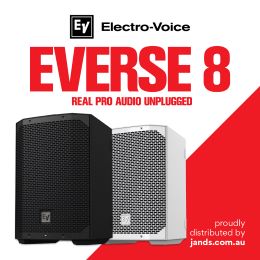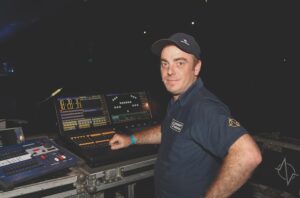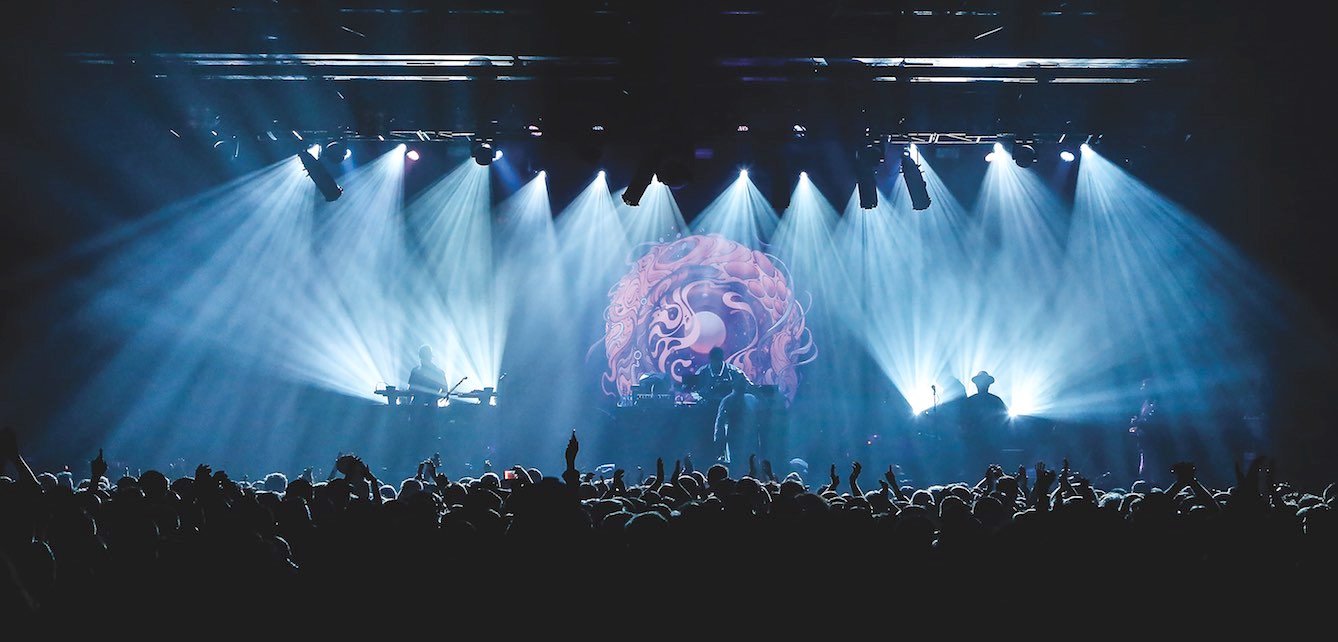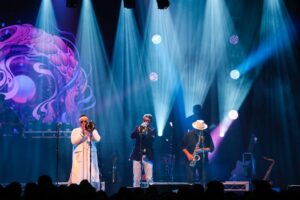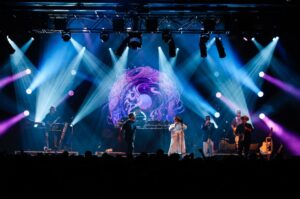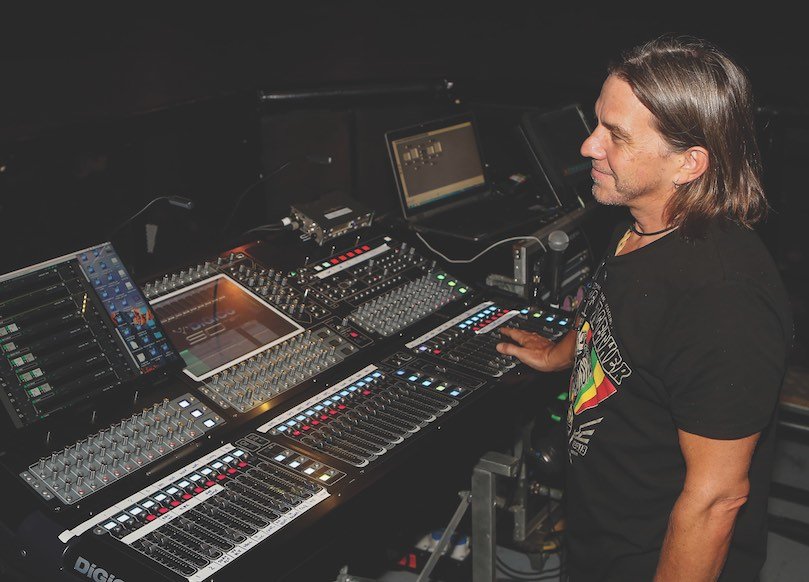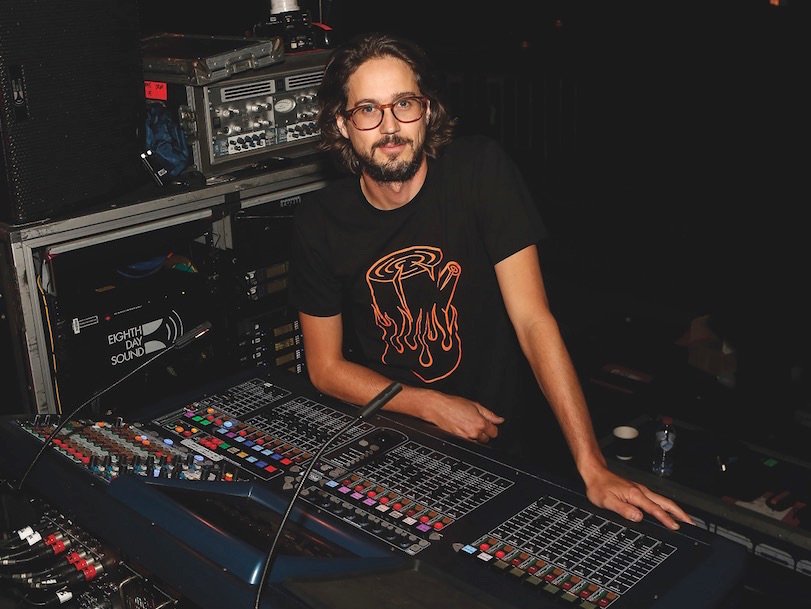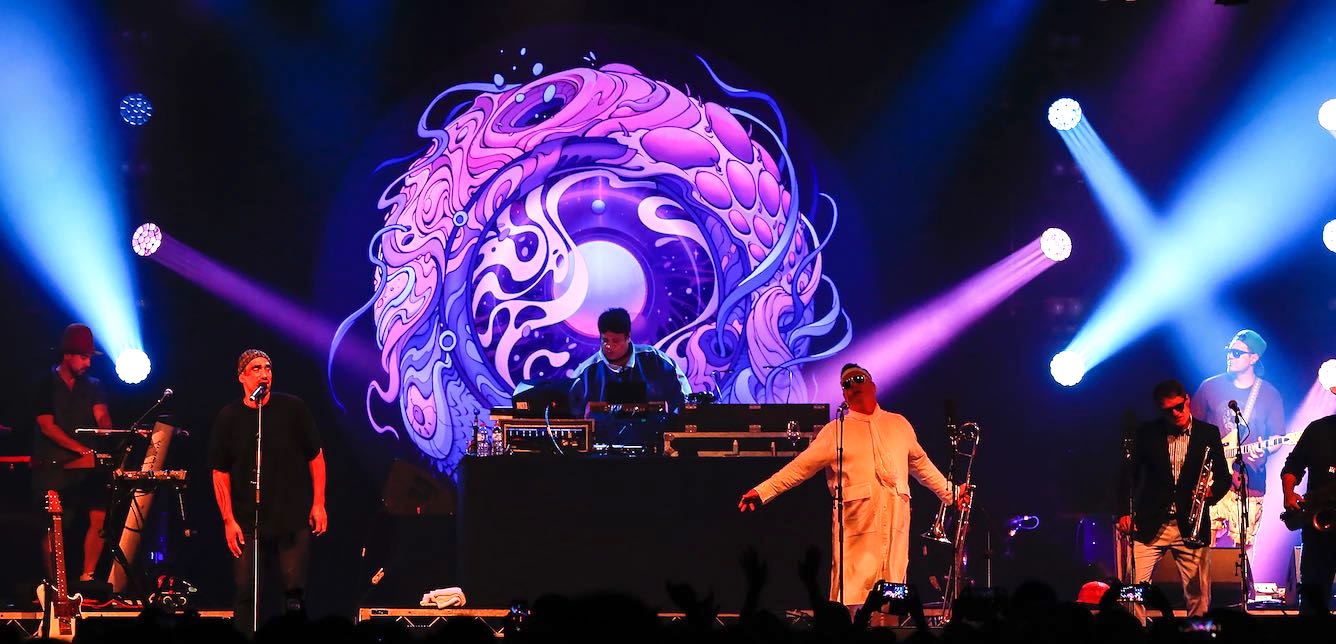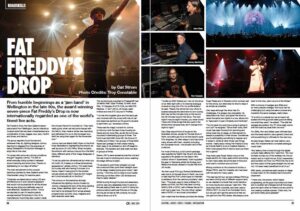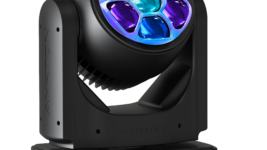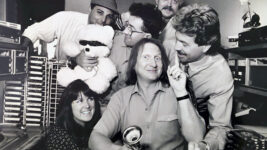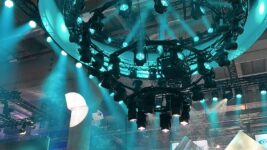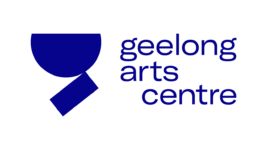Subscribe to CX E-News
ROADSKILLS
Fat Freddy’s Drop
by Cat Strom.
Photos: Troy Constable
From humble beginnings as a ‘jam band’ in Wellington in the late 90s, the award-winning seven-piece Fat Freddy’s Drop is now internationally regarded as one of the world’s finest live acts.
Fat Freddy’s Drop, the New Zealand seven-piece band from Wellington, has an infectious musical style that has been characterised as a combination of dub, reggae, soul, jazz, rhythm and blues, and techno. The group regularly tours Europe and whenever they do, lighting designer Johnny Bamford is released from the shackles of being Phaseshift’s Production Manager to enjoy life on the road.
“It comes with some very strong conditions though!” laughed Johnny. “I’m still on email everyday doing quotes in between sound checking and show time. There’s no sightseeing on our days off either.”
The main set element is the unusual backdrop painted by New Zealand artist Otis Chamberlain using UV reactive paint
“Originally we talked about using LED and animations but it soon became apparent that would not be practical for all the shows that we are doing and definitely was not cost effective,” explained Johnny.
“Once we decided to use UV reactive paints we approached Rockdrops in the UK to manufacturer it and they also custom made the circular frame it’s mounted on.
“They were really good; when we had some issues with the Velcro, they made a whole new backdrop and delivered it to us on the European tour. We’ll be using them again for the November tour.”
Johnny had one Martin MAC Viper on the front truss dedicated to highlighting the artwork as well as some UV LED PARs. When he lights the artwork with various colours from the MAC Viper, different parts of the image disappear or standout.
“It can be quite two dimensional but when you hit it with UV, it takes on a three dimensional appearance,” added Johnny. “It’s really been fun to play with and having it circular on a frame, meant it was good for the smaller venues where we didn’t have the trim height as it could actually sit on the floor.”
The colours on the backdrop strongly influenced the lighting colours chosen by Johnny, changing the look of the show lighting wise. Green definitely didn’t work with it and had to be stripped from songs already programmed, but pink, blue, magenta and dark lavender were ideal.
The rig (obviously supplied by Phaseshift) had 19 Martin MAC Viper Profiles, 22 MAC Aura XBs, 12 Claypaky B-EYE K10s, six MAC700 Washes, 11 GLP JDC1s, 25 Duets, eight 4-liters and nine ETC Source IV Profiles.
“I do like the tungsten glow and the band get very involved with the crowd with lots of call and response sections so it’s good to be able to light them up,” remarked Johnny.
Three was the magic number for Johnny on this tour with the back truss housing six Vipers and six Aura XBs, as did the mid truss, mounted in alternating groups of three. The front truss held MAC Aura XB, the Source IV Profiles and 4-liters.
Two groups of three MAC Vipers sat upstage on their cases making them easy to be wheeled on and off stage for festivals. The ladders and side wash are also in groups of three. Eleven JDC1s were spread across the mid and the rear truss for strobing and colour washing the stage without a beam.
“To be able to point them straight out over the crowd and then point them straight down on the stage created some good looks,” said Johnny. “I find the JDC1s have a much better dimming curve than other LED strobes and they’re really reliable.”
Whilst touring through Europe and elsewhere, Johnny was very adaptable when it came to fixtures saying there was no point in being too precious about particular fixtures on this gig. As long as he had an MA console, he could make a show out of it!
“I prefer an MA2 fullsize but I can do the show on an MA2 light with a 12-channel analogue console to plug into it for my profile faders,” he said.
“Nearly the whole two hour show is busked because the band tend to turn a song that may be five minutes long on the record into 25 minutes long for the show. The next night it may be eight minutes, you never know! I have only three songs that are cued in the whole show because they don’t change from night to night.”
Cam Elias was at front of house for the Australian shows, except for the last show in Perth, and although he is not the band’s usual FOH engineer, he often steps in and has done many shows with them, recently including two European tours – one at each end of the multicore.
For most of the tour, a full control package was supplied by Eighth Day Sound who also supplied a PA system for the Eaton Hill’s outdoor show in Queensland. VJam supplied the gear in Tasmania whilst the Sydney and Melbourne shows utilised in-house PAs from JPJ Audio.
“As their usual FOH guy Richard McMenamin was due to do the last show in Perth, we more or less kept his FOH control spec to maintain consistency from the various providers,” said Cam.
“The spec used to have a Midas Pro series out front, but Rich has been running DiGiCo SD5 or SD10, with a Waves Server for a bit over a year now. The only thing I added was a FATSO Jr. as a buss compressor.”
Cam noted that the Waves provided the Abbey Road Plates and H-Reverbs which worked well for this show, but otherwise he tried to keep it as simple as possible.
Cam says although the show has it’s challenges, it is always very enjoyable. He describes it as ‘fluid’, and given the show is rarely the same two nights in a row, allows him to “approach it open mindedly and intuitively”.
“You’re never too sure how a song is going to turn out!” he laughed. “Since their roots, their music has been formed from jamming and doing dubs live on stage, so that element is always a possibility in their shows.
“Sometimes you’re anticipating something to happen and it doesn’t, whilst at other times new things evolve. I really enjoy mixing Fat Freddy’s Drop as it lends itself to a lot of creative freedom. I think most people find it hard to even put them into a genre.”
They have used Royer ribbon mics on the brass section for many years which according to Cam have really stood the test of time and work well in monitors and out front. Mixing monitors on his console of choice, a Midas PRO2, was Ron Kessels who has been with the band for many years.
“The last big NZ tour we had a Midas PROX as we were running lots of different support acts so we needed a console that could handle a lot more inputs and outputs,” said Ron.
“We have tried other consoles, and even used a DiGiCo SD11 on one of our European tours, but we just can’t get the same tone that we can get from the PRO series. We always come back to the nice, warm sound of the Midas.”
With a mixture of wedges and IEMs and so many people onstage, Ron’s job can be challenging but using the same console and hopefully the same wedges, really helps.
“It is tricky in a sense but we do have it all sussed and the guys are really good at telling me what they want,” he added. “The d&b M4 wedges are perfect, the 15” drive really works with this band as does their low end.”
For IEMs, Ron and Dallas uses Ultimate Ears and the brass section use a generic brand but will be switching to Ultimate for the next tour. As lead singer Dallas can hear latency very well, Ron implemented a complete analogue vocal chain.
“Any latency that comes through the digital console really affects him,” said Ron. “So now his feed comes out of his wireless mic into an Avalon and is Y-split into an XL42, meanwhile I send another mix from my PRO2 into the XL42 and the output of that goes straight into his ear mix. It’s been really beneficial for all of us.”
With seven, sometimes eight people on stage to keep track of, Ron always has to be extra observant. “I have only one scene, which keeps progressing, as the guys improvise a lot there are no sudden set changes and all the songs glue into each other so there’s not any point to me creating multiple scenes. That’s why I’ve got some really good glasses!”
CX Magazine – May 2019 Entertainment technology news and issues for Australia and New Zealand – in print and free online www.cxnetwork.
© CX Media
Subscribe
Published monthly since 1991, our famous AV industry magazine is free for download or pay for print. Subscribers also receive CX News, our free weekly email with the latest industry news and jobs.





